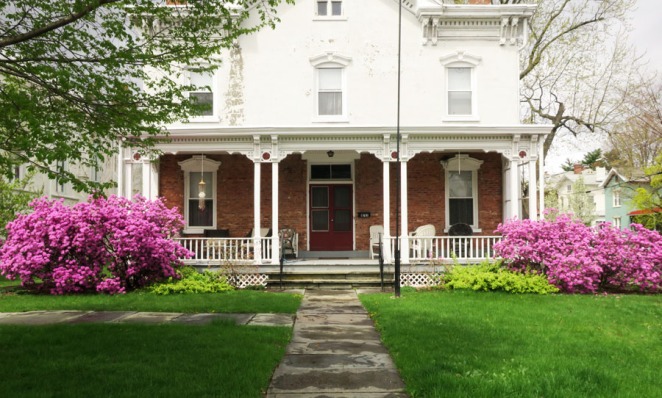A lot of my camera time is spent photographing historic structures. They could be anything from a fine house that’s been lovingly preserved to a ruin ready to succumb to the weather or the wrecker’s ball, and everything in between.
The question I always ask myself, especially if it’s a subject I’m photographing for the first time, is, how should I present this? As a straightforward record shot or in an artistic interpretation? Actually, as long as you’re there, it’s as well to do both. Record shots–or in this context one might say documentary shots–are, for me, a way of getting to know the subject: introducing my camera to it and vice versa. After I’ve taken one or more of those, I move in, look more closely, and evaluate the subject for possible artistic interpretations.
Saugerties, a river town on the Hudson River some 45 miles south of Albany, has a vast treasure of historic subjects, including the famous lighthouse that also serves as a B&B. Yesterday the light was just right for photographing a home that adjoins the Reformed Church–actually, it’s the parsonage for the church–because the rhododendrons were out in full force and offered a burst of spring beauty and color.
Here is the first image I made–the record shot: the front of the house with the door, windows, and, of course, the two rhododendron bushes.

But I wasn’t satisfied to stop there. It’s a good record shot, a bland postcard shot, one might say, but there must be something more here.
Of course, there was. After all, what had attracted me to the building in the first place–a building I walk or drive past frequently but had never before thought of photographing? The rhododendrons, of course. Here’s the result.

Please note: Both images are the jpgs “right out of the box,” with only minimal postprocessing. I’ll get to that stage later. But I want to point out that in this blog post I’m concerned primarily with the compositional aspects: how to get from the record or documentary shot to a personal interpretation. But there needn’t be a complete dichotomy between the two, because even a documentary shot can be transformed into something artistic depending on how you decide to process it. (This is especially useful for this historical photography because you can use a program such as Topaz B&W Effects or Nik Silver Efex Pro to make your documentary shot look like an old-fashioned historic photograph.) But that’s another story!
Back to composition: My fellow Hudson Valley photographer Robert Rodriguez, Jr. frequently writes about composition, and offers invaluable tips, in his blog and in his newsletter. If ever there was a photographer who proves that you don’t need to travel out West for the “iconic shots” to produce stunning photography, Robert is such a photographer. Click here to get to his website — I promise you’ll be glad you did. His motto is “Inspiring the Creative Spirit,” and that he certainly does.
It’s always interesting to see how a photographer approaches her or his subject. And I agree with you, often the record shot is maybe not the most interesting. I like the one you ended up with, it creates a feeling of depth and emphasizes one thing (the flowers) over everything. 🙂
Thanks, Otto. Sometimes when moved to pick up the camera and capture something, and I’m confronted with many possible elements that could go into the picture, I ask myself what attracted me to the subject to begin with. And then I figure out the best way to feature that. That’s how I arrived at this composition that would accentuate the flowers. Occasionally I find that comparing what’s in the viewfinder with what’s not in it helps: am I including the elements I really want? Are there things I ought to exclude, say, by moving in closer?